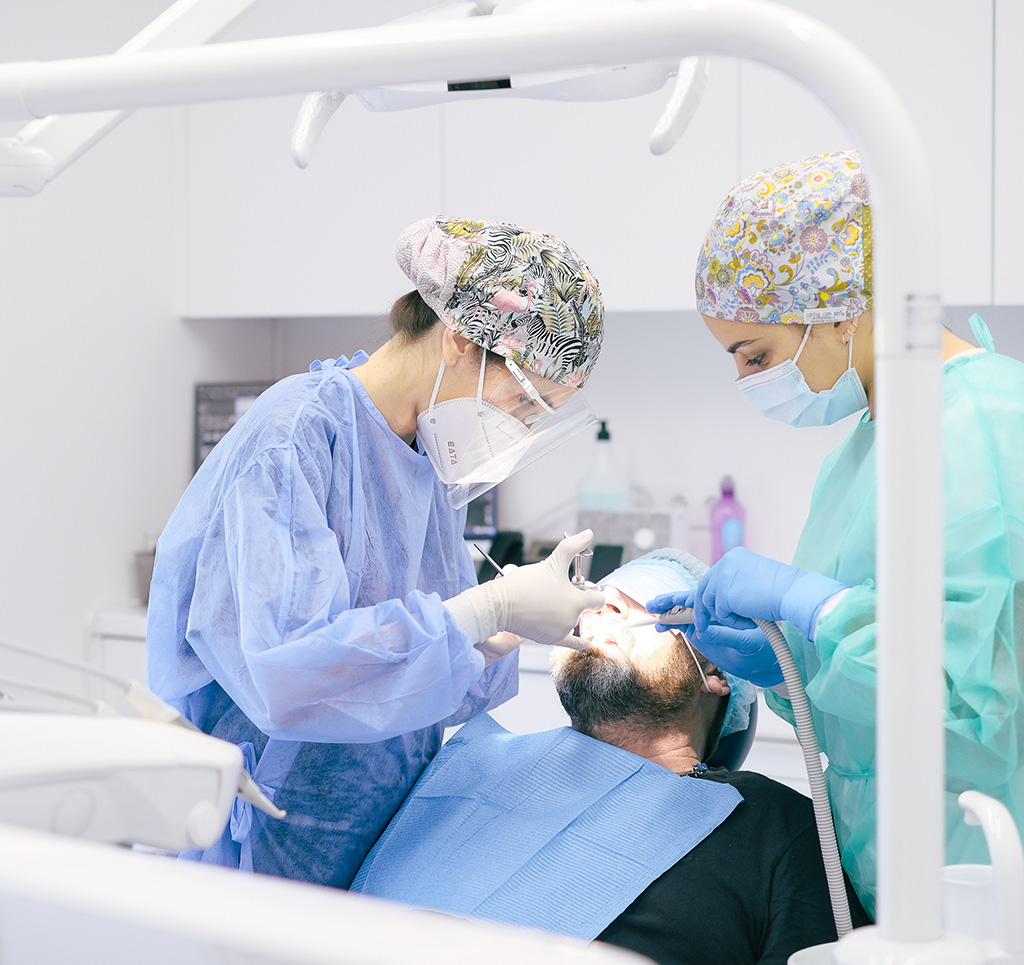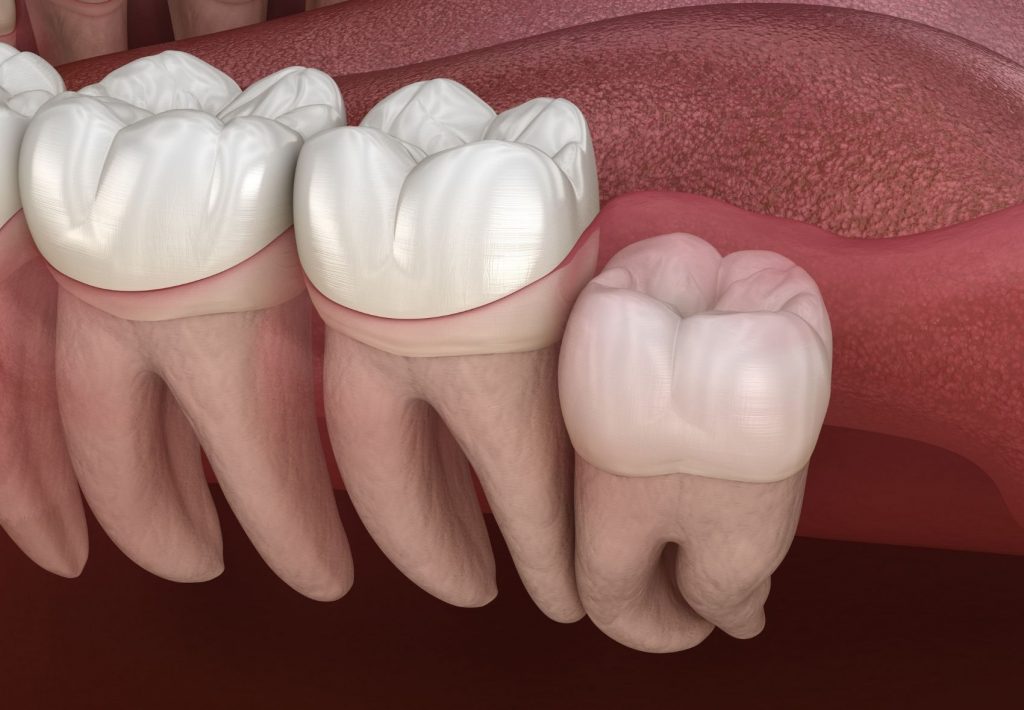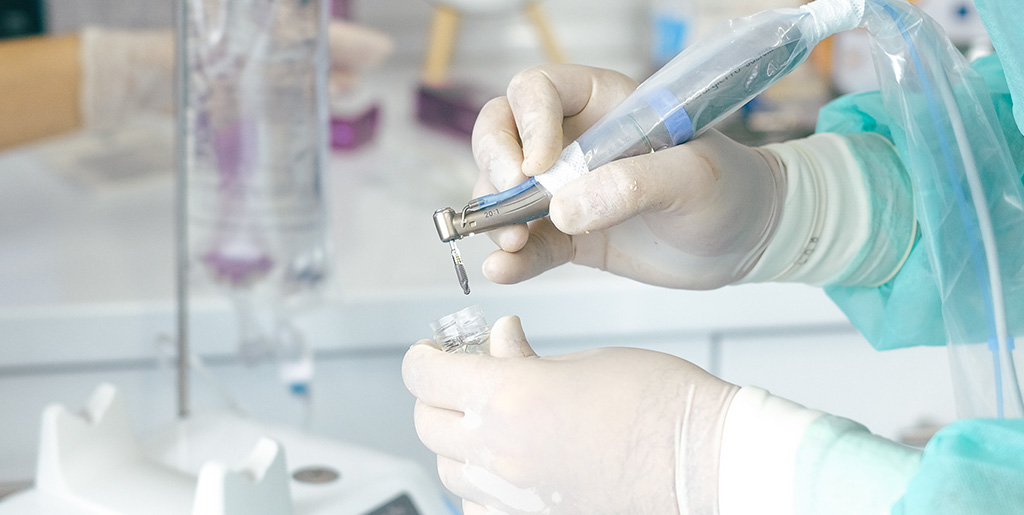
What is Oral Surgery?
Oral surgery is the speciality of dentistry responsible for the diagnosis and surgical treatment of pathologies of the oral cavity.
The field of action of oral surgery is very broad, including:
- extraction of impacted teeth, particularly wisdom teeth, or extraction of teeth present in the dental arch;
- endodontic surgery / apicetomy (when endodontic treatment is not sufficient to treat the lesion of that tooth);
- periodontal surgery;
- surgery to remove cystic or tumour pathology;
- bone graft surgery (increasing bone mass to allow dental implants to be placed);
- pre-prosthetic surgery (preparation of the oral cavity so that a dental prosthesis can be fitted);
- surgery for infectious lesions and surgical correction of dental and jaw trauma.
At the Instituto Dentário Alto dos Moinhos we have a team specialising in Oral Surgery, who, in conjunction with other areas of Dentistry, will design and carry out a multidisciplinary treatment, seeking to achieve a smile in harmony with the unique characteristics of each patient.
What is Oral Surgery?
Oral surgery is the speciality of dentistry responsible for the diagnosis and surgical treatment of pathologies of the oral cavity.
At the Instituto Dentário Alto dos Moinhos we have a team specialising in Oral Surgery, who, in conjunction with other areas of Dentistry, will design and carry out a multidisciplinary treatment, seeking to achieve a smile in harmony with the unique characteristics of each patient.

The field of action of oral surgery is very broad, including:
- extraction of impacted teeth, particularly wisdom teeth, or extraction of teeth present in the dental arch;
- endodontic surgery / apicetomy (when endodontic treatment is not sufficient to treat the lesion of that tooth);
- periodontal surgery;
- surgery to remove cystic or tumour pathology;
- bone graft surgery (increasing bone mass to allow dental implants to be placed);
- pre-prosthetic surgery (preparation of the oral cavity so that a dental prosthesis can be fitted);
- surgery for infectious lesions and surgical correction of dental and jaw trauma.
Types of Treatments
Dental Extractions
Tooth extraction, also known as exodontia, is a small operation performed to remove a piece of tooth. The teeth that are extracted most often are wisdom teeth, which, because they are the last to erupt, are the teeth that are most often included in the jaws.
Simple Dental Extractions
The surgery is performed under local anaesthetic, so that the patient feels no pain, just a sensation of pressure. The oral surgeon uses a lever to make the tooth more mobile, followed by the use of forceps to complete its removal. The extraction site may or may not need to be sutured.

Types of Treatments
Dental Extractions
Tooth extraction, also known as exodontia, is a small operation performed to remove a piece of tooth. The teeth that are extracted most often are wisdom teeth, which, because they are the last to erupt, are the teeth that are most often included in the jaws.

Simple Dental Extractions
The surgery is performed under local anaesthetic, so that the patient feels no pain, just a sensation of pressure. The oral surgeon uses a lever to make the tooth more mobile, followed by the use of forceps to complete its removal. The extraction site may or may not need to be sutured.

Complex Dental Extractions
Extractions that involve cutting into the bone or tooth to remove it are considered complex. This type of extraction is carried out on badly destroyed teeth, teeth that are “fused” to the bone and teeth that are included (completely inside the jaw) or semi-included (partially exposed in the oral cavity and partially inside the jaw).
Teeth can become included because of a lack of space in the arch, because they have an anomalous anatomy or because they are incorrectly positioned in the bone. If they are not removed, the constant pressure caused by their attempt to erupt can cause various problems, such as resorption or cavities in adjacent teeth, inflammation, pain, crowding (malpositioning of the teeth), and pathologies such as cysts and tumours. Wisdom teeth are the most frequently included teeth in the jaws.
Complex Dental Extractions
Extractions that involve cutting into the bone or tooth to remove it are considered complex.

This type of extraction is carried out on badly destroyed teeth, teeth that are “fused” to the bone and teeth that are included (completely inside the jaw) or semi-included (partially exposed in the oral cavity and partially inside the jaw).
Teeth can become included because of a lack of space in the arch, because they have an anomalous anatomy or because they are incorrectly positioned in the bone. If they are not removed, the constant pressure caused by their attempt to erupt can cause various problems, such as resorption or cavities in adjacent teeth, inflammation, pain, crowding (malpositioning of the teeth), and pathologies such as cysts and tumours. Wisdom teeth are the most frequently included teeth in the jaws.
Periodontal Surgery
They involve gingival tissue and bone graft surgeries, coronal lengthening and/or gingivectomies, frenectomies, resective surgeries and guided tissue/bone regeneration surgeries.
The recovery time for this type of surgery varies from patient to patient, but without any additional oral discomfort in comparison, and the patient must wear a hard palate protector for 8 to 14 days to protect the sutures in the areas that have undergone the intervention.
Periodontal Surgery
They involve gingival tissue and bone graft surgeries, coronal lengthening and/or gingivectomies, frenectomies, resective surgeries and guided tissue/bone regeneration surgeries.
The recovery time for this type of surgery varies from patient to patient, but without any additional oral discomfort in comparison, and the patient must wear a hard palate protector for 8 to 14 days to protect the sutures in the areas that have undergone the intervention.
Surgery to remove Cysts and Tumours
Cysts and tumours of the oral cavity are a broad group of lesions that must be identified and treated to prevent functional and aesthetic damage to the body.
They can appear at birth (congenital) or during the development of organs such as teeth, bones and gums, as a result of tissue irregularities and anomalies.
Surgical treatment of these pathologies involves specific techniques for each type of lesion.

Surgery to remove Cysts and Tumours
Cysts and tumours of the oral cavity are a broad group of lesions that must be identified and treated to prevent functional and aesthetic damage to the body.
They can appear at birth (congenital) or during the development of organs such as teeth, bones and gums, as a result of tissue irregularities and anomalies.
Surgical treatment of these pathologies involves specific techniques for each type of lesion.
Pathology of the Salivary Glands
The salivary glands are responsible for producing saliva. The most common dysfunction is dry mouth (xerostomia), resulting in problems with chewing, swallowing, nutrition, speech and breathing.
It can be caused by bacterial or viral infections, systemic disorders (Sjögren’s syndrome, HIV, Lupus, Diabetes or Alzheimer’s), tumours or interference from certain drugs.
To determine the cause of salivary gland pathologies, the most commonly used diagnostic methods are intraoral radiography, computerised tomography and salivary flow assessment.
Pathology of the Salivary Glands
The salivary glands are responsible for producing saliva. The most common dysfunction is dry mouth (xerostomia), resulting in problems with chewing, swallowing, nutrition, speech and breathing.
It can be caused by bacterial or viral infections, systemic disorders (Sjögren’s syndrome, HIV, Lupus, Diabetes or Alzheimer’s), tumours or interference from certain drugs.
To determine the cause of salivary gland pathologies, the most commonly used diagnostic methods are intraoral radiography, computerised tomography and salivary flow assessment.
Care after an Oral Surgery
Care in the post-operative period is very important to minimise the consequences of surgery and to promote healing and reduce discomfort. To summarise, the care to be taken is as follows:
- Apply ice to the face over the area being treated for the first 24 to 48 hours, every 10 to 15 minutes;
- Eat cold and soft food for the first 24 to 48 hours;
- Avoid sun exposure and physical exertion during the first week;
- Rest and sleep with your head elevated, for example use 2 pillows and don’t sleep on the operated side;
- Do not smoke during the first 24 to 48 hours;
- Brush teeth and tongue normally. In the surgical area, brush carefully with a surgical brush (very soft) after the first 24 hours;
- Mouthwash lightly 2-3 times a day with an antiseptic for one minute, starting 24 hours after surgery;
- Comply scrupulously with the medication prescribed by your dentist;
- If necessary, return to the clinic between 10 and 12 days after surgery for suture removal.
Care after an Oral Surgery
Care in the post-operative period is very important to minimise the consequences of surgery and to promote healing and reduce discomfort. To summarise, the care to be taken is as follows:
- Apply ice to the face over the area being treated for the first 24 to 48 hours, every 10 to 15 minutes;
- Eat cold and soft food for the first 24 to 48 hours;
- Avoid sun exposure and physical exertion during the first week;
- Rest and sleep with your head elevated, for example use 2 pillows and don’t sleep on the operated side;
- Do not smoke during the first 24 to 48 hours;
- Brush teeth and tongue normally. In the surgical area, brush carefully with a surgical brush (very soft) after the first 24 hours;
- Mouthwash lightly 2-3 times a day with an antiseptic for one minute, starting 24 hours after surgery;
- Comply scrupulously with the medication prescribed by your dentist;
- If necessary, return to the clinic between 10 and 12 days after surgery for suture removal.
Faq
The main reasons for tooth extraction are:
- the existence of a very deep carious lesion that makes it impossible to restore the tooth;
- infection involving a large part of the tooth structure or adjacent bone;
- lack of space in the oral cavity for all the teeth;
- the need to remove an included or semi-included tooth;
- advanced and generalised periodontal disease;
- severe bone loss.
Wisdom teeth, which normally number four and erupt around the age of 18-20, do not need to be extracted in all cases. The situation will always be assessed by the dentist who will weigh up different criteria depending on the clinical situation and determine whether or not there is a need for their removal.
Ideally, regular routine appointments should be kept to monitor the development of the third molars.
The main reasons for wisdom teeth extraction are lack of space in the arch to prevent crowding of the remaining teeth, partial or incomplete eruption leading to the appearance of an acute inflammation of the tissues called pericoronaritis, the formation of cysts or tumours, and difficulty in cleaning them.
CONTACT
Schedule yout Appointment
Leave your contact details and we’ll book your appointment within 24 hours.
